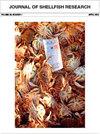墨鱼养殖的最新进展,Sepia Pharaonis Ehrenberg,1831
IF 1
4区 农林科学
Q3 FISHERIES
引用次数: 3
摘要
摘要墨鱼Sepia pharaonis Ehrenberg,1831,是印度-西太平洋地区广泛分布的热带头足类动物。这种墨鱼很容易受到沿海拖网渔船的影响,尤其是在早期,当它们在沿海水域产卵和幼鱼捕食时。法老墨鱼因其营养、药用和工业价值而在世界范围内非常受欢迎,但由于野生资源的过度开发和对活墨鱼需求的增加,保护野生墨鱼种群正成为一个严重的问题。法老墨鱼养殖技术的发展将有助于保护自然种群和生物多样性。为了了解其商业前景,对其分布、分类学、生物资源和营养价值进行了综述。由于强劲的市场需求和良好的利润,法老墨鱼养殖最近蓬勃发展,幼鱼和商业产品生产的技术进步也促进了这一发展。详细讨论了人工养殖、生物资源和生物特性的最新进展、养殖方法和法规方面的成就、生物技术在养殖中的应用和问题,以及进一步养殖的挑战,以了解法老墨鱼养殖的最新发展。本文章由计算机程序翻译,如有差异,请以英文原文为准。
Recent Developments in The Culture of the Cuttlefish, Sepia Pharaonis Ehrenberg, 1831
ABSTRACT The cuttlefish Sepia pharaonis Ehrenberg, 1831, is a widely distributed tropical cephalopod species in the Indo-West Pacific region. This cuttlefish is vulnerable to the influence of coastal trawlers, especially during early stages when they spawn and juveniles prey in coastal waters. The pharaoh cuttlefish is very popular worldwide because of its nutritional, medicinal, and industrial values, but the protection of wild cuttlefish populations is becoming a serious concern because of the overexploitation of wild resources and increasing demand for live cuttlefish. The development of culture techniques for pharaoh cuttlefish will help protect natural populations and biodiversity. To understand its commercial prospects, the distribution, taxonomic, biological resources, and nutritional values are summarized and reviewed. The promising culture of pharaoh cuttlefish flourished recently due to strong market demand and promising profit, and it has been facilitated by technical progress in the production of juvenile cuttlefish and commercial products. Recent advances in artificial breeding, biological resources, and biological characteristics, achievements in culture methods and regulations, the application of biotechnology in its culture and problems, and challenges to further culture are discussed in detail to capture the newest developments in pharaoh cuttlefish aquaculture.
求助全文
通过发布文献求助,成功后即可免费获取论文全文。
去求助
来源期刊

Journal of Shellfish Research
生物-海洋与淡水生物学
CiteScore
2.30
自引率
0.00%
发文量
40
审稿时长
6 months
期刊介绍:
Original articles dealing with all aspects of shellfish research will be considered for publication. Manuscripts will be judged by the editors or other competent reviewers, or both, on the basis of originality, content, merit, clarity of presentation, and interpretations.
 求助内容:
求助内容: 应助结果提醒方式:
应助结果提醒方式:


